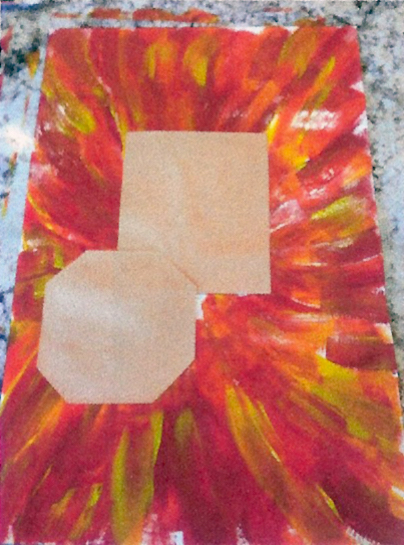By cutting and arranging squares and rectangles to create an image, students improve motor skills and enjoy a fun story. Recommended for Kindergarten.
Color: an element of visual art; the visible range of reflected light. Color has three properties: hue, value, and intensity.
Shape: a two-dimensional closed line, it can be geometric or organic. In this lesson, we will be using triangles to make squares and rectangles and using a circle for the moon.
Symmetry: an image made up of similar parts facing each other or around an axis.
Circle: a round figure with all points on the curved line equal distance from the center point.
Collage: a way of making a work of art by gluing different objects, materials, and textures to a surface.
Octagon: an eight-sided figure, with all sides being equal in length.
Portrait : A work of art created to show a person, animal, or group of people, usually focusing on the face.
Rectangle: a four-sided figure with two pairs of sides being equal in length, two pairs of sides are parallel and all angles being 90
Square: a four-sided figure with all sides being equal in length, two pairs of sides are parallel and all angles being 90.
Triangle: a three-sided figure.
Check out the book, In Like A Lion Out Like a Lamb, by Marion Dane Bauer.
Create one of each of the following items from the materials and supplies list per student:

There is an old saying: “March comes in like a Lion and goes out like a Lamb!” The winds or March encourage an exploration of contrasts from fierce winds and rains to gentle breezes and mist. March is a time of transition from winter to spring.
Read the book, In Like A Lion Out Like A Lamb, by Marion Dane Bauer, illustrated by Emily Arnold McCully or read this poem below while you are waiting for their paint to dry (step 6).
“In Like A Lion, Out Like A Lamb” by Lorie Hill
March roars in like a lion.
So fierce,
The wind is so cold,
It seems to pierce.
The month rolls on
And Spring draws near,
And March goes out
Like a lamb so dear.
Ask the students what they think March will be like this year.
Can students hold and manipulate a paint brush, learning to start at the center and paint outwards, and practice painting techniques?
Can Students use fine motor skills to cut and glue paper pieces to the background painting to resemble the facial features of a lion?
Students will identify shapes: square, rectangle, circle, triangle & octagon




Lesson written by Rebecca Schwenk.
Hale, Joyce P. “March - Lion and Lamb.” Poem of unknown publication
Hill, Lorie. “In Like A Lion, Out Like A Lamb.” Poem of unknown publication
Bauer, Marion Dane. And McCully, Emily Arnold, Illustrator. In Like A Lion Out Like A Lamb. New York, New York. Holiday House Publishers, 2012. Print.
21st Century Thinking Habits & Skills
Observing, making connections, visualizing, sequencing, comparing/contrasting (squares & rectangles), determining main idea, cause and effect, decision making (if they create a mood for the lion).
WA State 2017 Learning Standards
(VA:Cr1.1.K) a. Engage in exploration and imaginative play with materials.
(VA:Cr2.1.K) a. Through experimentation, build skills in various media and approaches to art-making.
(VA:Cr3.1.K) a. Explain the process of making art while creating.
(VA:Re7.2.K) a. Describe what an image represents.
(VA:Re8.1.K) a. Interpret art by identifying subject matter and describing relevant details.
Arts Integration Opportunities
Science: Track weather for the month of March and see if it did ‘come in like a lion and go out like a lamb.’
Please note: These lesson plans are intended for non-profit use only. Use of these plans for commercial purposes should give attribution to the Issaquah Schools Foundation and be accompanied by a nominal donation at www.isfdn.org/donate. Thank you.
Fueling Success for Every Student, Every School